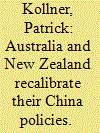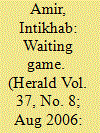| Srl | Item |
| 1 |
ID:
178744


|
|
|
|
|
| Summary/Abstract |
Australia and New Zealand (NZ) have in recent years been at the forefront of the growing confrontation between the ‘West’ and China. Despite very close economic ties with China, both countries have substantially changed their approaches to dealing with the People’s Republic. In this article, I take stock of and compare the Australian and NZ recalibrations of their respective China policies, highlighting similarities as well as differences across the two country contexts and over time. It was Australian federal state actors who first embarked on a major ‘reset’ of China policy, culminating in legislation on espionage and foreign interference in 2018. After a change in government, state authorities in NZ appeared to follow Australia’s lead. However, NZ’s adjustment of its China policy has been less straightforward, more contested and overall more ambiguous. Small-state theories partly explain NZ’s more ambivalent approach. A more comprehensive understanding can be gained by reference to how NZ differs from its Tasman neighbour in terms of strategic outlook, including the paramount importance accorded to trade in its foreign affairs.
|
|
|
|
|
|
|
|
|
|
|
|
|
|
|
|
| 2 |
ID:
162174


|
|
|
| 3 |
ID:
132564


|
|
|
|
|
| Publication |
2014.
|
| Summary/Abstract |
Low earth orbit has become increasingly congested as the satellite population has grown over the past few decades, making orbital debris a major concern for the operational stability of space assets. This congestion was highlighted by the collision of the Iridium 33 and Cosmos 2251 satellites in 2009. This paper addresses the current state of orbital debris regulation in the United States and asks what might be done through policy change to mitigate risks in the orbital debris environment. A brief discussion of the nature of orbital debris addresses the major contributing factors including size classes, locations of population concentrations, projected satellite populations, and current challenges presented in using post-mission active debris removal to mitigate orbital debris. An overview of the current orbital debris regulatory structure of the United States reveals the fragmented nature of having six regulating bodies providing varying levels of oversight to their markets. A closer look into the regulatory policy of these agencies shows that, while they all take direction from The U.S. Government Orbital Debris Mitigation Standard Practices, this policy is a guideline with no real penalty for non-compliance. Various policy solutions to the orbital debris problem are presented, ranging from a business as usual approach to a consolidated regulation system which would encourage spacecraft operator compliance. The positive aspects of these options are presented as themes that would comprise an effective policy shift towards successful LEO conservation. Potential economic and physical limitations to this policy approach are also addressed.
|
|
|
|
|
|
|
|
|
|
|
|
|
|
|
|
| 4 |
ID:
072571


|
|
|